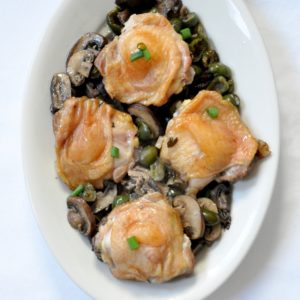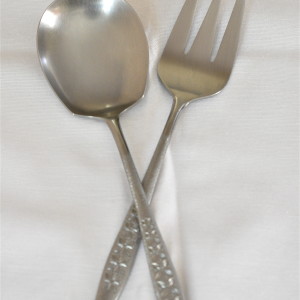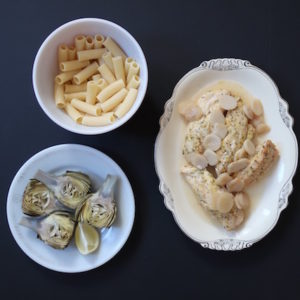Warm Chicken Liver Salad
Friends, I’d like to share a theory with you.
It’s called “The Theory Of Paid.”
January 14th, in addition to celebrating the legacy of Martin Luther King, we observed the anniversary of the Northridge Earthquake. This 6.9 event took place at 4:31 a.m. in Northridge, California, on January 14, 1994. Why do I know so much about it? John and I were in the epicenter. We’d moved in together three weeks earlier. Only the night before, I’d finished the last unpacking.
We were very lucky. The apartment building we moved into was built courtyard style, with the front doors arranged around a pool. We already knew our neighbors, and they us. The apartment manager was already a friend; twenty years on, she is one of my dearest friends.
The experience of that earthquake was singular and horrifying. I was certain we would die, crushed by the building’s upper floors. Every window broke. Glass crashed down into the courtyard. Every car alarm shrieked. People screamed in terror. The noise was phenomenal. But the building held.
When the shaking stopped, a neighbor, remembering John, who was still walking (albeit unsteadily), came to help us out. We found our neighbors and huddled on the sidewalk, waiting for daylight. Somebody with a Walkman called out the news.
When the Northridge Meadows building fell, three soft thumps, I turned to John and said: “What’s that?”
We wouldn’t learn of the devastation until sunrise. I had decided against renting an apartment there weeks ago.
So, my theory of paid goes like this: we are now immune to horrible earthquakes. This immunity extends to friends and loved ones.

It follows, by theory of paid, that no more rock musicians will die in 2016.
—
Okay, I saw some of you blanch up there at chicken livers. That’s why I put “warm” in the recipe title. Even John, normally so easygoing, isn’t hugely fond of these.
If you are among the chicken-liver-haters, either you’re a victim of poorly prepared livers or somebody who classes them with all variety meats, refusing to touch them. Which is sad.
Plenty has been written by greater writers than myself about the American relationship with variety meats, or offal, or “the nasty bits.” Having grown up in a household where chicken livers were served regularly and happily eaten, I never thought them unusual. Three words: don’t overcook them. Nobody like gray erasers for dinner.
If you are in camp chicken liver, wonderful. If you’re on the fence, I urge you to try these. If chicken livers disgust you, read Bee Wilson’s The First Bite, which I finished last night. It’s an engrossing look at the ways early eating habits impact later ones, with interesting news on how adult eating can change for the better.
Actually, everyone should read The First Bite. It’s a great book.
About this recipe: the chicken livers come from yours truly, as do the salad and vinaigrette. Remembering the artichokes in the vegetable bin led to another memory: Jeff Tunks’ Warm Artichoke And Chicken Liver Salad, scissored from Gourmet Magazine heaven knows when. This recipe is inspired by that one, which I recall featured the chef’s 100+ pound weight loss, accomplished by tasting food using small spoons instead of taking indiscriminate tastes.
If you are unable to get fresh artichokes, canned or frozen may be substituted. If your canned artichokes are marinated, rinse them well.
Chicken livers are filling, with a single pound serving 2-3 adults, depending on appetite and what else is at table. You may also uncouple the recipe components like train cars, serving them separately. Together, they’re a textural delight: the spicy warmth of the livers, the cool crunch of salad leaves, the artichoke’s velvety bitterness, with the vinaigrette smoothing everything. It just works.
Warm Chicken Liver Salad
Yield: enough for 2-3 adults, depending on what else is served
Prep time: Chicken livers: approximately 40 minutes, including prep
Artichokes: 5 minutes prep, 1 hour cooking
Salad greens and vinaigrette: moments
Note: cook artichokes, then prepare chicken liver, then salad.
For the chicken livers:
1 pound chicken livers, organic if possible
1/3 cup flour
1 teaspoon salt
1/2 teaspoon black pepper
1/2 teaspoon fennel seed, ground
1/2 teaspoon paprika
1/2 teaspoon coriander, ground
1/2 teaspoon cumin, ground
1/4 teaspoon red pepper flakes
Olive oil for the pan
Vermouth or Madeira for the pan
garlic clove, peeled (optional)
For the artichokes:
2 medium artichokes, trimmed (see below for instructions)
1 small lemon
For the salad:
approximately 1 1/2-2 cups salad greens of your choice: ideally include Romaine for crunch
scallion or spring onion, sliced in thin rings (optional)
For the vinaigrette:
1/4 cup good olive oil
Champagne or white wine vinegar to taste; see below for instructions
Begin with the artichokes, which take longest to cook. Bring a pot of water on the stove to the boil (as the English say). Add a handful of salt. Squeeze in the lemon, tossing in the peels if you’d like.

To prepare artichokes, you’ll need a serrated knife and a vegetable peeler. Begin by breaking off the outer dark leaves until you reach the inner, lighter yellow leaves. Your artichoke may be dirty. Just give it a rinse. Mind the spiky leaf tips, which you should cut off.
Now you have the bulging bottom stem and heart, topped by yellow leaves. Take the vegetable peeler and “turn” it around the heart, trimming off any sharp or inedible edges, being careful not to slice into the heart. If you choke has a nice long stem, peel it, but don’t cut it off. What lies within is a delicious extension of the heart.

Some cookbooks advise yanking the heart out now. I find it easier going once the artichoke is cooked.
Drop the artichokes into the boiling water, cover the pot with a lid, and allow to cook for a good hour. It’s almost impossible to overcook an artichoke.
Clean up all those leaves and wash your knives. Artichokes do weird things to metal. Now move the clothes to the dryer (You have to, right?). Now call your significant other and remind him to contact the respiratory therapist about the stupid BiPap alarm that went off twice last night. Give the kitty her earmite medicine.
Okay. Chicken livers!
Chicken livers are highly perishable, so you don’t want to leave them out at room temperature too long. Defrost them in the fridge. To clean, set livers in a colander and run cool water over them. Gently tug off visible fat. If you see green, remove that, too, very carefully–it’s the bile sac, and breaking those makes for bitterness. Should you break one, just rinse well with water.
Pat livers dry with paper towels. I do this right in the colander.
Place a large skillet on the stove. Pour a generous amount of olive oil into the pan, just under a quarter-inch, and turn the heat to medium.
Now we’re going to coat the livers with seasoned flour. More energetic types would use egg and panko and more plates. And it would be good. Me, I tip the flour and seasonings into a pasta bowl, then lightly dredge each liver. You want to just coat, not spackle.

Transfer your lightly coated livers to a clean dish.

When all the livers are ready, add them to the skillet, along with the optional garlic clove, which is there for flavor.
A slug of Vermouth is nice here. A slug of Madeira is even nicer.
Okay, here is something I do you’ll either love or hate. I like to dump the leftover seasoned flour into the skillet. This means the livers will be a mix of crisp and gungy, with the extra coating cooking into utter yumminess, but some people will find this revolting and just want a crisply coated liver. If that’s you, toss the leftover flour.
Elizabeth David hated the word “crispy.” But she adored chicken livers.
Now we get to the crux of the matter: cooking the livers. While you need a fairly snappy heat, you also need to turn the livers the moment you notice blood pearling up. Here’s what livers look like when they need flipping. This is not a pretty picture. Not all of them can be.

You may also need to turn the livers a few times to ensure their various “faces” cook. If the pan starts running dry, add a little more wine, water, or even a bit of olive oil.
All this said, you want livers pink in the middle. Not red, pink. Another doneness test: does your spatula cut through a liver cleanly and effortlessly? It’s cooked.
Cooking the livers should take about ten minutes, total. Transfer to a plate and leave someplace warm while you check the artichokes.
Test your artichokes by jabbing a fork into the bottom of one. If it slides right through, you’re in business. Resistance? Cook a little longer.
Once the artichokes are ready, drain them in your freshly washed colander (ahem…). While they cool enough to handle, prepare your salad greens.
Lay the washed, dried salad leaves of your choice in a dish. If you’d like a little sliced scallion, add it. Our market had fresh garlic, before it separates into heads. I used that.
Top with a serving of chicken livers. Hopefully by now the artichokes are cool. Slice them in half. Scrape choke out with a teaspoon. Quarter the heart and add to the salad.

For the vinaigrette: vinegar is a matter of taste. I suggest adding a teaspoon of white wine or Champagne vinegar to the olive oil, blending with a whisk or fork, then tasting. You may wish to add a little more vinegar or salt.
Pour over salad. Eat.
Frozen or canned artichokes may be substituted for fresh; if canned artichokes are marinated, be sure to rinse well before using.





